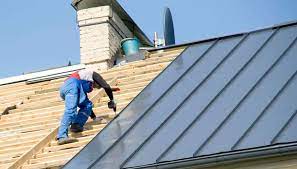Getting Homeowners Insurance With a Bad Roof
When getting homeowner's insurance, it's important to understand the details behind it.
Most states require a policy to cover wind, fire, and hail damage, but the type of roof you have can impact your coverage. Generally, a roof's age, slope, and construction all factor into how much your homeowner's insurance will cost. Read to get the full details on how to get homeowners insurance with a bad roof.
Know the limits
A homeowner's policy typically covers the cost of repairing a roof damaged by a storm, fire, or hail. But there are limits — depending on the insurance company and policy, the insurance company might only pay up to a certain amount.

Get a Separate policy.
A roof is a major investment, and many homeowners insure their roofs separately under a separate policy. While many homeowners have a separate policy for their roofs, not everyone does. The roof's age, material type, and condition are all factors that affect how likely it is to leak — and, therefore, how expensive it is to repair. If the conditions of your roof are old or in disrepair, the cost of repairing it could be more than your deductible. In this case, you can get a separate policy for your roof.
How to Claim Home insurance with a bad roof
You can take several steps to get homeowner's insurance if you have a damaged roof or suspect your roof may be damaged.
Get a free inspection.
The insurance company can you to get a licensed contractor to inspect your roof, or they may accept an estimate directly from a licensed contractor. Your policy will specify what's covered and what's not.
The insurance company may ask for roof and roof system information, including:
The age of the roof
The type of roofing materials used

Repair or replacement costs
History of hail damage and repairs
A history of fire or lightning damage
A history of leaks
History of wind damage
A roof's condition affects its value, and that value affects whether your insurance policy covers any repairs or replacements.
The insurance company may also ask for repair estimates and estimates from a roofing contractor. If the insurance company accepts the estimates, it will use the costs to determine your coverage and the amount you owe.
Get an estimate
Once you have the assessment result, you can use that information to estimate how much it will cost to fix your roof or replace it.
Get a roof replacement estimate.
Once you have a quote, you can decide whether it's worth repairing your roof or getting a new roof altogether.
File a claim
Once you've made your decision, contact your insurer and file a claim. In some circumstances, the insurance company may deny your claim.
Reason for delay or denied claim
It may require proof that the damages occurred under your roof or that you didn't cause them.
It may also require you to prove that you followed the insurance company's procedure for filing claims.
Also, some companies may deny your claim because of insufficient roof coverage. If your home has a storm or hail roof, for example, you may have no coverage if the policy does not cover your roof’s material or composition.
Other companies may deny your claim if your roof's age is too old. If it's more than ten years old, some insurance companies may no longer cover it.
If your insurance company denies your claim, you can appeal the decision to state insurance commissioners, who have the authority to enforce insurance.
Get paid
If your roof is deemed structurally sound, you'll get a cheque from your insurance company and get paid.
Final Words
Homeowners insurance protects you from fire, theft, natural catastrophes, and many other risks. The insurance company will pay for repairs or replacement of damaged property up to your policy's limit. When looking for homeowners insurance, it's smart to shop around and compare quotes. That way, you can pick the policy with the best price.
Related Articles
- Top Insurance Providers in the World
- The different types of health insurance plans you should know about
- Challenges Facing the Insurance Industry Today
- The insurance industry. Growing and Declining Sectors
- What You Need To Know About Auto Insurance For Teenagers
- The Benefits and Risks of Life Insurance. Do you need one.
- Do I Qualify For Life Insurance If I Have A Pre-Existing Disease
- Everyone Should Have These Insurance Policies
- Mistakes You Can Make When Claiming Your Homeowner's Insurance
- Factors Affecting Cost Of Travel Insurance
Reading Rankings
- What Does Your Car Insurance Policy Not Cover?
- The Major Policies Offered Under Property Insurance Cover
- What Is The Role Of A Home Insurance Broker?
- What Is Umbrella Insurance? How Does It Work?
- The Different Types of Insurance Companies
- How To Make A Claim For Your Stolen Car
- Factors affecting travel insurance costs
- Getting Homeowners Insurance With a Bad Roof
recommended
![]()
How Covid-19 has affected the Insurance Industry
![]()
Factors affecting travel insurance costs
![]()
What are the principles of good insurance?
![]()
The role and importance of insurance
![]()
Do I Require Insurance For My Home-based Business?
![]()
Understanding Mortgage Insurance and Homeowners Insurance
![]()
Top Insurance Providers in the World
You might like
- Everyone Should Have These Insurance Policies
- Mistakes you may make when applying for homeowners insurance
- 2022’s Top Car Insurance Companies
- What You Need To Know About Auto Insurance For Teenagers
- Why You Should Get Over 60s Life Insurance
- The Insurance Industry’s Trends
- Lapses: An Overview
- Reasons you may need to file a travel insurance claim







